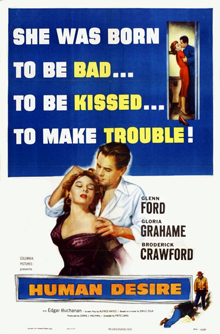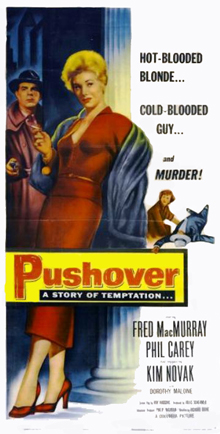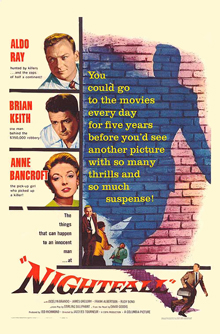
 |
|
|
|
Sony reaches into its vaults once again for a new selection of great 1950s thrillers. Columbia Pictures Film Noir Classics II samples work by top directors, highlighting films that show the noir style adapting to changing times. Noir angst is still the central focus, but its source is more impersonal. The earlier films in the stack look back to previous forms, while the newer entries describe new post-war anxieties: alienation, insecurity, and a new kind of conformist ruthlessness. The collection is a showcase for top noir talent. Forties stars like Glenn Ford, Richard Conte and Fred MacMurray are here, along with new faces Aldo Ray, Vince Edwards and Brian Keith. The tough/tender women in jeopardy include Anne Bancroft and Gloria Grahame; we also witness the film debut of star Kim Novak. 
Fritz Lang studies the relationship of character to fate in 1954's Human Desire, a remake of Jean Renoir's French classic La bête humain, from a novel by Émile Zola. The original film is a prime exponent of Poetic Realism, a French school of films about working-class people betrayed by their own passions. Transposed to the wholesome milieu of Middle America, the tale still convinces thanks to near-perfect casting. Fresh from fighting in Korea, railroad engineer Jeff Warren (Glenn Ford) falls in love with Vicki (Gloria Grahame), the abused wife of the older, unstable stationmaster Carl Buckley (Broderick Crawford). Carl pressures Vicki to ask an executive -- who molested her as a younger woman -- for his job back, and then murders the man in a fit of rage. Jeff withholds his suspicions about the killing, while Carl threatens Vicki with a compromising letter. Committed to Vicki, Jeff follows Carl to the freight yard, to commit a murder of his own. Fritz Lang would not have been allowed to film the sordid details of Renoir's story at any American studio. The Production Code demanded the violence be toned down and all transgressors be punished, and the studio insisted that Glenn Ford play a virtuous working man free of mental illness. No American railroad would cooperate with a movie about murders occurring on their trains. With some of the filming moved to Canada, Lang had to do without Rita Hayworth, his first choice to play Vicki, because a child custody case prevented her from leaving the country. Instead of three flawed characters set on a collision course, Human Desire gives us a psychotic villain, his compromised wife, and a relatively pure hero. Fritz Lang deftly suggests a few of the original's seamier extremes while stressing his own brand of environmental determinism. Precise montages of trains at work mirror similar fishing industry sequences in his earlier Clash by Night, and POV shots of crisscrossing rails imply that our fate depends on our choices. Lang's masterful direction places his characters in darkened sleeping cabins and forces the lovers to meet in rail yard shacks. But the stylized 40s ambience of eternal night and shadow is gone. Glenn Ford and Gloria Grahame are reunited from the previous year's The Big Heat, where they didn't even share a kiss. Gloria Grahame's Vicki is a needy, battered woman who does seem to love Jeff. But she's not the "right woman" for him. In a nod to healthy values, Alfred Hayes' screenplay holds the virginal Ellen (Kathleen Case) in reserve, waiting patiently for Jeff to come to his senses. Once again, the Production Code's insistence on wholesome values constrains film noir's erotic drive. As with all the films in this Classics II collection, Human Desire is a picture perfect B&W transfer, enhanced for widescreen. Usually shown full-frame on cable broadcasts, the film gains significantly when cropped to its proper widescreen aspect ratio -- the drama is much more focused. 
1954's Pushover reminds us strongly of parts of Double Indemnity combined with Alfred Hitchcock's Rear Window. Once again playing a man seduced into murder for money and a woman, Fred MacMurray reprises his part from the Billy Wilder masterpiece, with the difference that he's now ten years worse for wear and less cocky about himself. Richard Quine's direction disguises the fact that most of the movie plays out in the same two or three sets. Pushover is the debut picture of Kim Novak, who emerges fully developed as a passive beauty guaranteed to inspire extreme male misbehavior. On the track of bank robber Wheeler and $200,000 in stolen loot, detective Paul Sheridan (Fred MacMurray) picks up Wheeler's girlfriend, Lona McLane (Kim Novak) in the line of duty. He and his partner Rick McAllister (Phil Carey) keep a 24-hour watch on the McLane apartment. Lona realizes that Paul's a cop and suggests that they do away with Wheeler and run away together with the money. Paul figures a way to accomplish this without his superiors finding out. Meanwhile, Rick is attracted to the woman in the next window over from Lona's apartment, nurse Ann Stewart (Dorothy Malone), but resists getting involved with her while on the job. When the stakeout seems to go wrong, Lt. Eckstrom (E. G. Marshall) takes a more active role in the case, complicating Paul's shaky inside-man scheme. Pushover's makers flesh out their derivative storyline with plenty of clever touches. The male surveillance of the females in their apartments is voyeurism plain and simple, with Lona aware of her observers in a way that reminds us of peepshows in movies like Hardcore and Paris, Texas. Lona's scripted behavior is somewhat inconsistent. She instigates the murder idea in much the same manner as does Barbara Stanwyck in Double Indemnity, but from then on seems mostly a passive puppet. She follows Paul's explicit instructions to do things like draw Paul's partners away from the crime scene, etc. This "obedience factor" mirrors Kim Novak's sexual compliance in the later classic Vertigo. Noir critics have commented about partner Rick's use of binoculars to "window shop" for the right girl. Another detective clearly enjoys watching the women disrobe, but Rick keeps things on a professional level. He doesn't tell Ann Stewart what he's doing, even after she responds positively to his he-man treatment of a masher (Paul Picerni). Pushover presents a vision of relationships equally as perverse as those of Human Desire, yet no situations arise that would drop a flag before the Production Code's censors. MacMurray's Paul Sheridan chases the twin dream of money and romance, and is almost clever enough to succeed. The ending reaches for romantic resonance when Paul states that, "Maybe we didn't really need the money." But as venality is what motivates Wheeler, Lona and Paul, we must conclude that the characters are once again fooling themselves. 
Trimmed of its final two minutes, The Brothers Rico would be a prophetic masterpiece of modern paranoia to match Don Siegel's Invasion of the Body Snatchers. With barely more resources than the average TV show, director Phil Karlson turns French scribe Georges Simenon's thriller into a vision of the underworld as an inhuman, pervasive social monster. Critics studying fifties' anxieties will find a full statement here: our complacent surface world is completely unaware of an underlying Mabuse-like "empire of crime" that respects no human values. Forties noir icon Richard Conte is perfect as a cog from the old Mafia who believes that the mob will allow him a free and legitimate lifestyle. Not until Francis Coppola's glamorized Godfather films did American movies present the "corporate" transformation of organized crime in such powerful terms. Ex- mob accountant Eddie Rico (Conte) runs a successful laundry business and with his younger wife Alice (Dianne Foster) hopes to adopt a child. But a call from crime chieftain Sid Kubik (Larry Gates) insists that Eddie locate his younger brothers Johnny and Gino (James Darren & Paul Picerni). The two men have disappeared after performing a mob slaying, and Kubik fears that they might be cooperating with federal investigators. Realizing that his brother's lives are in danger, Eddie rushes to find them. Gino is convinced that he's already a marked man, but Eddie counsels him to do as Kubik says. Eddie must go to New York to get a lead on his youngest brother Johnny. He stops in briefly with his mother (Argentina Brunetti), who doubts that Kubik has her boys' best interests at heart. As Eddie proceeds to the small town in Arizona where Johnny and his new wife Norah (Kathryn Grant) are hiding out, he realizes that he's bumping into too many "friendly" old-time mob associates. Should he be telling Johnny to return to the fold, or to flee for his life? The Rico brothers are not innocent men, but they became part of the old mob through loyal family ties. Their mother once "stopped a bullet" meant for Sid Kubik, and the older man repeatedly asserts that he considers the Rico boys to be his own. But the "new" mob does not value human relationships. Absolute loyalty is required of members, but every underling is an expendable pawn. Personal freedom is impossible because the mob keeps close tabs on its personnel. Eddie's progress is monitored at every step. He's given a lift by New Yorker Vic (Richard Bakalyan), a wiseguy who pretends he's just being friendly. The Phoenix airport is watched by Charlie Gonzales (Rudy Bond), who glad-hands Eddie with an invitation to a roadhouse casino. When Eddie finally discovers that he's been played as a sucker, it's far too late. "Nothing personal", says Mike Lamotta, a thug who holds Eddie prisoner in a hotel room. The Brothers Rico seems more relevant now than it did in 1957, provided we ignore its absurd, cheerful epilogue. The mob operates more or less like a modern corporation, independent from meaningful government oversight. Making money is its only goal. A strict internal hierarchy is imposed at all times. Members can't talk about "company business" and will invite suspicion if they don't demonstrate full compliance with company policies. The only difference is that mob employees can't quit. The mob is clearly "too big to fail". The Brothers Rico is very cleanly designed by art director Robert Boyle. This is minimalism at its best. Johnny's farm hideout is seen only from one establishing wide shot. When the mob's cars arrive quietly on the roadway outside, the angle contains all we need to know. Until its conclusion, this very chilling film shows no overt violence: the implied threats are enough to hold it together. 
Jacques Tourneur (Berlin Express, Out of the Past) returns to noir turf with 1957's Nightfall, a faithful-in-spirit adaptation of the suspenseful novel by David Goodis. Tourneur once again infuses a story of murderous double-crosses with intelligence and poetic effects. Crooks John and Red (Brian Keith & Rudy Bond) trace commercial artist James Vanning (Aldo Ray) to his Hollywood apartment. Vanning at first thinks that model Marie Gardner (Anne Bancroft) has set him up but then relies on her to help him survive his ordeal. The previous Fall in Wyoming, John and Red confronted the vacationing Vanning and murdered his doctor friend. A mix-up with bags left Vanning in possession of the loot, which he buried in the snow. Vanning and Marie must now flee north to recover the money, pursued by the thieves and by Ben Fraser (James Gregory), an insurance investigator convinced that they're all criminals. Nightfall begins with a romantic title tune sung over Hollywood traffic at sundown, but soon sees its hero James Vanning beaten in a remote oil field. Marie Gregory barely escapes the onerous Red and John at an open-air fashion show on Wilshire Boulevard. David Goodis' book was a feverish first-person account of growing paranoia, but Tourneur and writer Stirling Silliphant back away from Vanning's personal viewpoint without sacrificing tension. As in Out of the Past the hero is at a loss in the dark alleys of the urban setting, but the snowbound Wyoming landscape changes the rules, giving Vanning a fighting chance. Like most films by Jacques Tourneur, Nightfall has its own rhythms and special character graces. Gravel voiced Aldo Ray is excellent as the haunted Vanning, a tough guy who is also believably gentle. Brian Keith must work hard to impress as a threat to the more imposing-looking Aldo Ray. Anne Bancroft is encouraged to give Marie an extra dimension as well; for once the idea of a woman dropping everything to follow a strange man into danger seems wholly credible. Nightfall is the rare 50s American noir thriller that captures the ambience of its hardboiled pulp source. 
The surprise hit of last year's Columbia Pictures Film Noir Classics I was Murder by Contract, an effective hit-man tale starring Vince Edwards. Director Irving Lerner's immediate 1959 follow-up City of Fear uses the same producer, art director and cameraman (Lucien Ballard of The Wild Bunch). With a budget that seems even smaller than before, Lerner found other tech talent at the beginning of impressive careers: editor Robert Lawrence (Spartacus, El Cid) and composer Jerry Goldsmith. City of Fear's pared-down story is more suited to a TV show -- The Alfred Hitchcock Hour episode The Dividing Wall (1963) used the exact same idea. The script is a collaboration by actor-writer Steven Ritch and Robert Dillon (X: The Man with the X-Ray Eyes). Escapee Vince Ryker (Edwards) thinks he's stolen a sealed container of heroin for use in medical experiments on fellow prisoners. The unshielded canister, the size of a coffee thermos, actually holds deadly radioactive isotope Cobalt-60. Vince has no idea that his treasure is slowly killing him. Police Chief Jensen, Lt. Richards and Dr. Wallace (Lyle Talbot, John Archer & screenwriter Steven Ritch) are afraid to start a panic by going public, and instead wait for Ryker to trip himself up. Unable to cash in his find, Ryker comes down with flu-like symptoms that won't go away. City of Fear looks assembled from bits and pieces. While Ryker tangles with unreliable dope contacts, the three authority figures policemen fret and worry. John Archer seemingly repeats his role from ten years back in White Heat. Despite the movie's overall competence we keep wondering why Ryker isn't concerned that his canister can't be opened. Doesn't any drug runner first confirm what he's carrying? City of Fear's camera roams atypical Los Angeles locations like the Melrose district and Sunset Blvd, but its finale appears to have been shot on a studio lot to save money, as had a major scene in Murder by Contract. Without an action conclusion, it's left to Vince Edwards' acting to lend some punch to the downbeat ending. City of Fear shows talented filmmakers making do with a minimum of filmic resources. Jerry Goldsmith's music score, his second theatrical effort, gives the picture a major boost. Sony's DVD collection Columbia Pictures Film Noir Classics II contains nigh-perfect enhanced widescreen transfers of these rewarding late-period noir thrillers. Each film comes on its own disc and includes an original theatrical trailer. The other extras are limited to short interviews with Martin Scorsese, Christopher Nolan and Emily Mortimer. Scorsese offers a few useful comments on The Brothers Rico but the other two spokespeople mostly communicate their personal reactions to the movies. We know that the changing market for DVDs has caused most companies to cut back drastically on their extras, but we still miss the expert commentaries on the first set of Columbia Noirs. Our interest increases with each new release of arcane and eccentric Noir titles.
On a scale of Excellent, Good, Fair, and Poor,
Reviews on the Savant main site have additional credits information and are often updated and annotated with reader input and graphics. Also, don't forget the 2010 Savant Wish List. T'was Ever Thus.
Review Staff | About DVD Talk | Newsletter Subscribe | Join DVD Talk Forum |
| ||||||||||||||||||